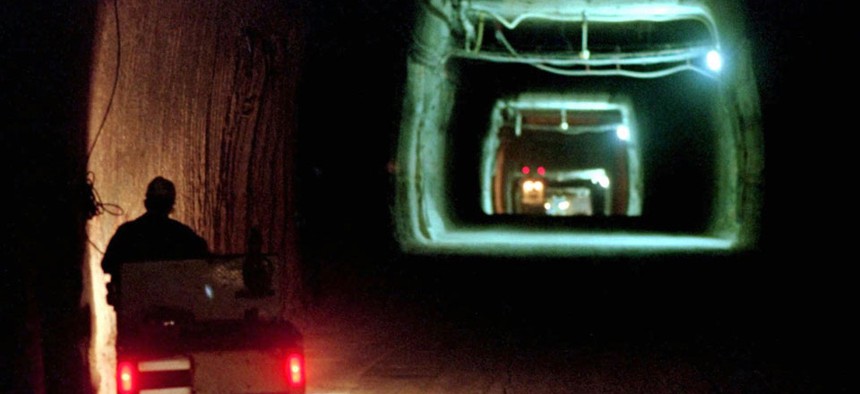Workers Exposed to Radiation at Nuclear Weapons Waste Dump

A worker drives a cart through a tunnel inside the Waste Isolation Pilot Plant 2,150 feet below the surface near Carlsbad, N.M. Eric Draper/AP File Photo
Thirteen employees tested positive after Feb. 14 leak at the New Mexico site.
The Department of Energy has acknowledged that 13 workers at its nuclear waste dump 26 miles southeast of Carlsbad, N.M., tested positive for radiological contamination following an underground leak on Feb. 14.
Exposed personnel were working above ground at the 16-square-mile facility, Joe Franco, manager of the Energy Carlsbad Field Office, said in an open letter sent Wednesday to the 120,000 residents who live near the Waste Isolation Pilot Plant.
WIPP stores waste generated in development of nuclear weapons in salt caverns 2,150 feet below the surface. On Monday, Franco downplayed the effects of the leak during town meeting, the Carlsbad Current-Argus reported.
Franco said in his letter that worker exposure was determined through the collection of preliminary bioassay samples. “Additional samples will be collected from these employees in the weeks ahead in order to perform complete analyses,” he said.
WIPP stores clothing, tools, rags, residues, debris, soil and other items contaminated with radioactive elements, including plutonium, from the development and production of nuclear weapons. The site currently stores 3.2 million cubic feet of waste in drums stacked throughout the caverns.
Franco said the Feb. 14 leak consisted primarily of americium-241, a contaminant in nuclear weapons manufacturing that is also used in smoke detectors.
Determining exposure levels typically involves multiple sample analyses to assess an employee’s radionuclide excretion rate over time, used to estimate the employee’s accumulated internal dose, Franco said. “Follow-up urine samples may require about three or more weeks to accurately predict dose,” he added.
WIPP is “now focusing our sampling program on employees with work assignments that may have placed them at greater risk, including those on shift Feb. 15. We are still reviewing staff assignments to determine if additional employees will need to be tested,” Franco said.
Energy has consistently touted the safety of WIPP, which received its first waste shipment in 1999, and has a pending request to store more toxic “high level” waste and waste from commercial nuclear power reactors.
At a press conference last week, Franco said it will be three weeks before officials are able to return underground to assess exactly what caused the leaks. During that time, Energy will develop safety plans to deal with potential radiation, health and mining hazards, he said.
Ryan Flynn, secretary of the New Mexico Environment Department, told reporters attending the press conference that “events like this should never happen . . . one event is too many.”
Get the Nextgov iPhone app to keep up with government technology news.






